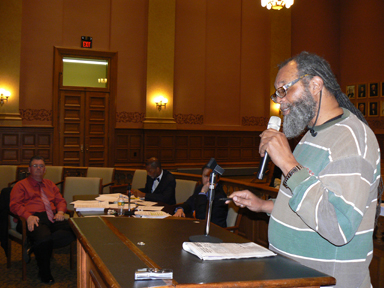Severn Willis stepped up to the podium in the City Council Chambers of Jersey City’s City Hall on April 22 and asked a piercing question regarding chromium cleanup in his neighborhood:
“How could the corporation counsel advise the city administration to settle for 20 parts per million?”
Willis, a longtime resident in the city’s Bergen-Lafayette section, was referring to the city’s settlement with Pittsburgh-based PPG Industries, Inc., for the cleanup of the 900 Garfield Ave. site, where PPG operated from 1954 to 1963.
20 parts per million is the highest standard for chromium cleanup in New Jersey
________
The settlement also calls for PPG to pay Jersey City $1 million to fund the acquisition of open space and $250,000 for Jersey City overseeing the cleanup.
The 20 parts per million is the highest standard used for chromium cleanup in the state of New Jersey at the present time, referring to the amount of chromium considered acceptable to remain in the soil. However, a recent report by the science and research division of the state’s Department of Environmental Protection found the 20 parts per million cleanup standard may be too relaxed.
The city’s settlement with PPG calls for a 20 parts per million cleanup down to 20 feet into the soil to make sure that chromium contaminants do not reach ground water.
Exposure to hexavalent chromium has been found in various medical studies to increase the risk of lung cancer and other ailments.
Willis, along with other residents living in the area, is in agreement with the report and want complete cleanup, as in zero parts per million or no traces of chromium. The residents also made their views known at a public hearing on the settlement on March 30.
Answering the question
The city’s corporation counsel, head of the city’s Law Department Bill Matsikoudis, answered Willis’ question by first saying that the city’s administration during Mayor Jerramiah Healy’s tenure was the first group of officials to take action in pursuing chromium cleanups across the city like the one pending at 900 Garfield Ave.
Matsikoudis also said the standard is “the most stringent in the nation” and that if there were stricter standards ever adopted by the state, PPG under the settlement would apply those standards when cleanup begins.
The city now is considering suggestions given at the March 30 meeting, and is engaged in further negotiations in which they are working out an updated settlement with PPG and the state. Then the matter goes the City Council, who will also have to approve the settlement. But residents will have input again before any new settlement is adopted.
Last week, Felicia Collis, who lives near the Garfield Avenue site, said she would like see the highest standards applied to the cleanup and wants more discussion and input before the settlement is official. She has been speaking at public meetings and protested outside City Hall for the stricter standard.
“This is as important as anything I have ever been involved in my life,” Collis said. “You only get one shot at this and why not have the settlement be the best possible for the public.”
Ricardo Kaulessar can be reached at rkaulessar@hudsonrreporter.com.
